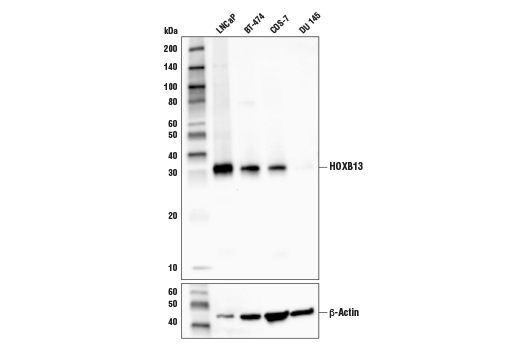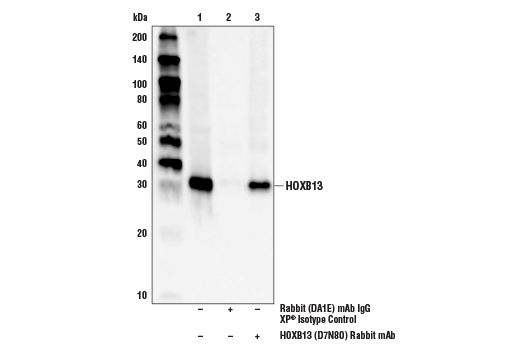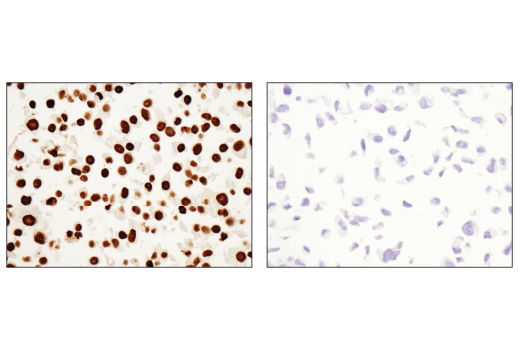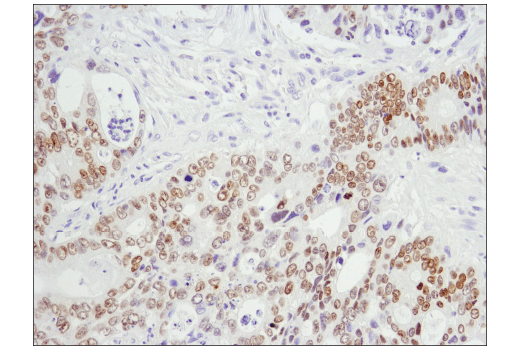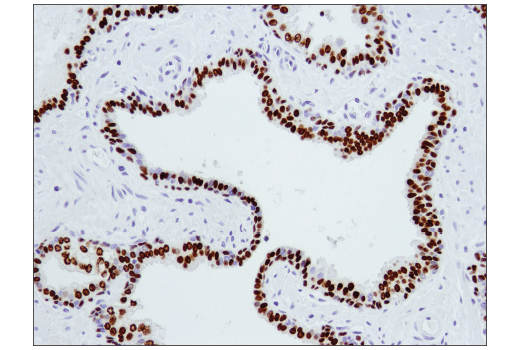WB, IP, IHC-P
H Mk
Endogenous
30
Rabbit IgG
#Q92826
10481
Product Information
Product Usage Information
| Application | Dilution |
|---|---|
| Western Blotting | 1:1000 |
| Immunoprecipitation | 1:50 |
| Immunohistochemistry (Paraffin) | 1:100 |
Storage
For a carrier free (BSA and azide free) version of this product see product #85470.
Specificity / Sensitivity
Species Reactivity:
Human, Monkey
Source / Purification
Monoclonal antibody is produced by immunizing animals with a synthetic peptide corresponding to residues surrounding Gly11 of human HOXB13 protein.
Background
HOXB13 is a member of the HOXB cluster which, along with the HOXA, HOXC, and HOXD clusters, governs embryonic patterning along the cranio-caudal axis (1,2). HOXB13 plays a key role in the development of the ventral prostate, where it is expressed highly from the embryonic stage through adulthood (3,4). Research studies have shown that both overexpression and RNA interference can inhibit the growth of prostate cancer cells. HOXB13 can function as a tumor suppressor by negatively regulating growth through repression of TCF4 and androgen receptor (AR) signaling (4,5). However, HOXB13 has also been shown to be overexpressed in more invasive prostate cancers, breast and ovarian cancers, and hepatocellular carcinomas (6-9). A common germline mutation G84E in the HOXB13 protein has recently been found to be associated with significant increased risk of prostate cancer (10). Currently, HOXB13 is being evaluated as a marker for metastatic lesions of prostate origin (11,12).
- McGinnis, W. and Krumlauf, R. (1992) Cell 68, 283-302.
- Zeltser, L. et al. (1996) Development 122, 2475-84.
- Economides, K.D. and Capecchi, M.R. (2003) Development 130, 2061-9.
- Jung, C. et al. (2004) Cancer Res 64, 3046-51.
- Jung, C. et al. (2004) Cancer Res 64, 9185-92.
- Jeong, T.O. et al. (2012) Mol Med Rep 5, 901-4.
- Shah, N. et al. (2013) Cancer Res 73, 5449-58.
- Miao, J. et al. (2007) Proc Natl Acad Sci U S A 104, 17093-8.
- Zhu, J.Y. et al. (2014) Int J Clin Exp Pathol 7, 2925-33.
- Ewing, C.M. et al. (2012) N Engl J Med 366, 141-9.
- Barresi, V. et al. (2016) APMIS 124, 188-93.
- Varinot, J. et al. (2016) Virchows Arch 468, 619-22.
Species Reactivity
Species reactivity is determined by testing in at least one approved application (e.g., western blot).
Western Blot Buffer
IMPORTANT: For western blots, incubate membrane with diluted primary antibody in 5% w/v BSA, 1X TBS, 0.1% Tween® 20 at 4°C with gentle shaking, overnight.
Applications Key
WB: Western Blotting IP: Immunoprecipitation IHC-P: Immunohistochemistry (Paraffin)
Cross-Reactivity Key
H: human M: mouse R: rat Hm: hamster Mk: monkey Vir: virus Mi: mink C: chicken Dm: D. melanogaster X: Xenopus Z: zebrafish B: bovine Dg: dog Pg: pig Sc: S. cerevisiae Ce: C. elegans Hr: horse GP: Guinea Pig Rab: rabbit All: all species expected
Trademarks and Patents
Limited Uses
Except as otherwise expressly agreed in a writing signed by a legally authorized representative of CST, the following terms apply to Products provided by CST, its affiliates or its distributors. Any Customer's terms and conditions that are in addition to, or different from, those contained herein, unless separately accepted in writing by a legally authorized representative of CST, are rejected and are of no force or effect.
Products are labeled with For Research Use Only or a similar labeling statement and have not been approved, cleared, or licensed by the FDA or other regulatory foreign or domestic entity, for any purpose. Customer shall not use any Product for any diagnostic or therapeutic purpose, or otherwise in any manner that conflicts with its labeling statement. Products sold or licensed by CST are provided for Customer as the end-user and solely for research and development uses. Any use of Product for diagnostic, prophylactic or therapeutic purposes, or any purchase of Product for resale (alone or as a component) or other commercial purpose, requires a separate license from CST. Customer shall (a) not sell, license, loan, donate or otherwise transfer or make available any Product to any third party, whether alone or in combination with other materials, or use the Products to manufacture any commercial products, (b) not copy, modify, reverse engineer, decompile, disassemble or otherwise attempt to discover the underlying structure or technology of the Products, or use the Products for the purpose of developing any products or services that would compete with CST products or services, (c) not alter or remove from the Products any trademarks, trade names, logos, patent or copyright notices or markings, (d) use the Products solely in accordance with CST Product Terms of Sale and any applicable documentation, and (e) comply with any license, terms of service or similar agreement with respect to any third party products or services used by Customer in connection with the Products.
